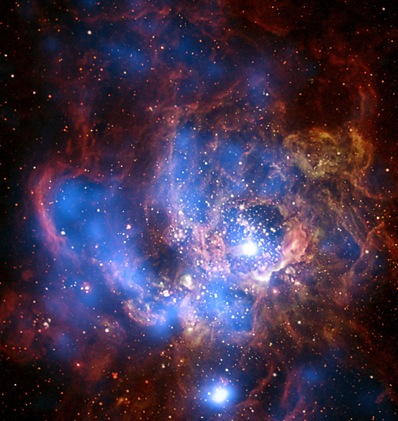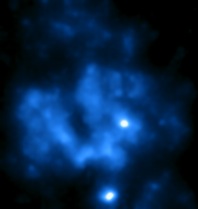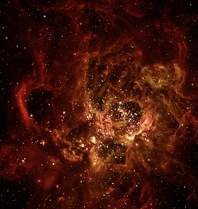|

Top Stories

|

|
 |
 |


Supermassive black holes not guilty of shutting down star formation
...Galaxies cease star formation long before their supermassive black holes have the power to do the job themselves...
read more

Eminent speakers gather for IYA kick-off
...The International Year of Astronomy officially kicked off with a grand opening in Paris last week...
read more

Astronomers discover super-Neptune
...Astronomers have discovered a planet 4.7 times the size of Earth and 25 times more massive...
read more |
 |
 |

|
Spaceflight Now +

|

|
 |
 |

Subscribe to Spaceflight Now Plus for access to our extensive video collections!
 How do I sign up? How do I sign up?
 Video archive Video archive

STS-120 day 2 highlights

Flight Day 2 of Discovery's mission focused on heat shield inspections. This movie shows the day's highlights.

 Play Play

STS-120 day 1 highlights

The highlights from shuttle Discovery's launch day are packaged into this movie.

 Play Play

STS-118: Highlights

The STS-118 crew, including Barbara Morgan, narrates its mission highlights film and answers questions in this post-flight presentation.

 Full presentation Full presentation
 Mission film Mission film

STS-120: Rollout to pad

Space shuttle Discovery rolls out of the Vehicle Assembly Building and travels to launch pad 39A for its STS-120 mission.

 Play Play

Dawn leaves Earth

NASA's Dawn space probe launches aboard a Delta 2-Heavy rocket from Cape Canaveral to explore two worlds in the asteroid belt.

 Full coverage Full coverage

Dawn: Launch preview

These briefings preview the launch and science objectives of NASA's Dawn asteroid orbiter.

 Launch | Science Launch | Science

 Become a subscriber Become a subscriber
 More video More video

|
 |
 |

|
|
 |

Wall of gas divides
cosmic metropolis
BY DR EMILY BALDWIN
ASTRONOMY NOW
Posted: 28 January, 2009
A new study from the Chandra X-ray Observatory unveils the star-forming factory NGC 604 as a divided neighbourhood.
NGC 604 is the largest region of star formation in the nearby galaxy M33, and now Chandra has presented the first deep, high resolution view in X-rays of this cosmic metropolis, home to some 200 hot, young, massive stars. Giant bubbles permeate the cool dust and warm gas, which are filled with diffuse, multi-million degree X-ray emitting gas. It is likely that these bubbles are blown out by the powerful stellar winds produced by new-born stars, and are immediately repopulated with the hotter material observed by Chandra.

This composite image from Chandra X-ray Observatory data (colored blue), combined with optical light data from the Hubble Space Telescope (red and green), shows a divided neighborhood where some 200 hot, young, massive stars reside. Image: X-ray: NASA/CXC/CfA/R. Tuellmann et al.; Optical: NASA/AURA/STScI.
However, there is also a curious landmark in this star-forming city: a wall of gas that splits the region into two territories bearing different characteristics. To the west (right side of the image), the amount of hot gas measured in the bubbles corresponds to about 4,300 times the mass of the Sun. This value, combined with the brightness of the gas in X-rays, implies that this district is entirely powered by winds from the 200 hot massive stars.
This presents something of a paradox, since previous modeling of other stellar bubbles usually predicted them to be fainter than observed, requiring additional heating from supernova remnants to match the observations. But in this area of young stars, none or perhaps only a small fraction of the massive stars could have already exploded as supernovae.
 
Chandra X-ray (left) and Hubble optical (right) images of the divided neighbourhood in NGC 604. Image: X-ray: NASA/CXC/CfA/R. Tuellmann et al.; Optical: NASA/AURA/STScI).
On the eastern (left) side of NGC 604, the X-ray gas contains 1,750 times the mass of the Sun, but winds from young stars cannot explain the brightness of the X-ray emission. However, since the bubbles on this side appear to be much older they were therefore more likely to have been created and powered by young stars and supernovae in the past. The separation is also seen in the optical results and implies that a massive wall of gas shields the relatively quiet region in the east from the active star formation in the west.
The study was led by Ralph Tuellmann of the Harvard Smithsonian Center for Astrophysics and was part of a deep, 16-day long observation of M33 called the Chandra ACIS Survey of M33, or ChASeM33.
|
 |
 |
 |
|
|



